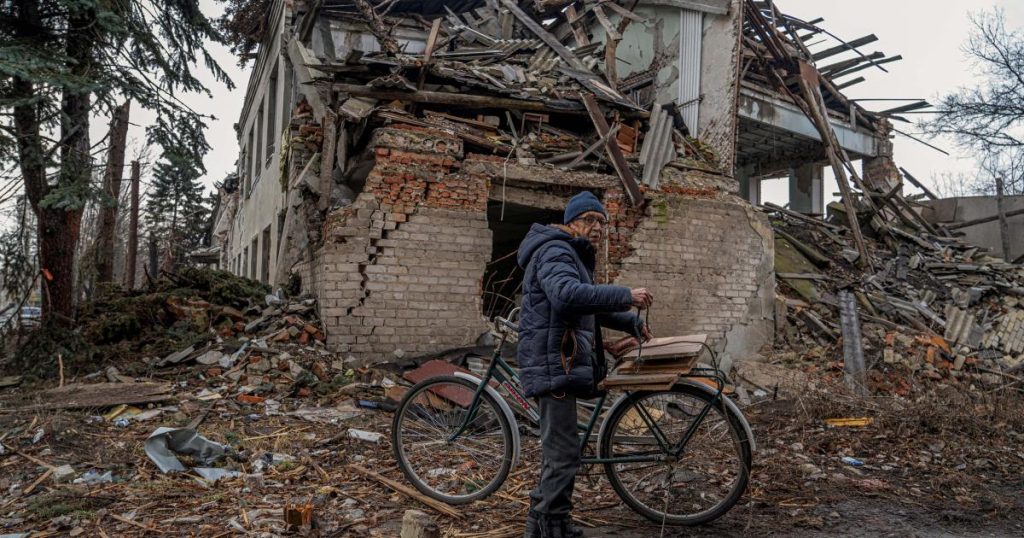Today, about 20 percent of southeastern Ukraine is under Russian occupation, including Crimea and large parts of the Donetsk, Luhansk, Kherson, and Zaporizhzhia regions. Russian President Vladimir Putin has painted the war in Ukraine as a nationalist campaign to repel Western advances and reclaim territory that, in his view, rightfully belongs to Russia. But conquest has another motivation: economic gain. If Russia maintains military control over these regions, it may be hoping to reap that benefit. At this stage, however, it is hardly clear that they would become economic assets for Moscow; supporting the war-torn territories could just as easily become a drain on its coffers.
The human costs of this war are enormous. Russian forces are ruling occupied Ukraine with an iron fist, engaging in a ruthless campaign of torture, kidnapping, violence, and arbitrary killing. Any assessment of the war’s economic consequences should not minimize its awful depravity or the immense suffering it has inflicted. But its economic outcome will affect future judgments of Putin’s decision to invade in February 2022. If Russia benefits economically from the occupation of Ukraine, the war may be remembered as a strategic success, albeit a coldblooded one. If Russia instead suffers economically, the invasion will be seen as a self-defeating, barbaric blunder.
The outcome will also influence other would-be aggressors’ appetites for territorial expansion and imperialism, which have remained mostly dormant since the end of World War II. The economic potential—or lack thereof—in Putin’s conquered territories might influence North Korean leader Kim Jong Un’s assessments of the wealth that his country could absorb by conquering South Korea, Chinese President Xi Jinping’s appetite for seizing Taiwan and its technologically advanced semiconductor industry, or even the sort of thinking behind U.S. President Donald Trump’s speculation about seizing Canada, Greenland, and the Panama Canal.
With fighting in Ukraine at a bloody stalemate and neither side capable of a breakthrough, the time has come to contemplate the fate of eastern Ukraine under a protracted, if globally repudiated, Russian occupation. The net benefits that can be gained from occupied or annexed regions depend chiefly on how much is destroyed in their conquest and what proportion of the population resists or flees. The devastation of war, thousands of deaths, and flight of working-age residents since Putin’s 2014 invasion and 2022 escalation, and the recalcitrance of those who remain, will greatly limit Russia’s gains from conquest, without even considering the staggering cost in Russian lives of wresting these territories from Ukrainian control.
FLEEING CONQUEST
In 2014, Russia occupied and annexed the Ukrainian region of Crimea and supported separatist forces in taking over parts of the Donetsk and Luhansk regions. Its invasion in early 2022 failed to topple the government in Kyiv, but the Russian military did expand its control to 60 percent of the Donetsk region, almost all of the Luhansk region, and—completing a Russian ring around the Ukrainian side of the Sea of Azov—much of the Kherson and Zaporizhzhia regions. Although Crimea is the only one of these regions that Russia controls entirely, it has declared its formal annexation of them all.
But depopulation poses severe limits on Russia’s potential economic gains from these conquests. In 2014, Ukrainians began fleeing Crimea, and especially the Donetsk and Luhansk “People’s Republics” that Russia established in eastern Ukraine, to escape the lawlessness, fighting and because they preferred Ukrainian to Russian rule. The intensification of combat in 2022 reignited this flow of people from Donetsk and Luhansk to parts of Ukraine that remained free and to other European countries, and precipitated similar mass departures from Kherson and Zaporizhzhia.
Firm numbers are hard to come by, but data from the International Organization of Migration and our own calculations indicate that there are at most five million Ukrainians still living in the five regions under Russian occupation—a 56 percent decline from the 11.4 million who lived there prior to 2014. The total number obscures the even more drastic emptying that has occurred in the four occupied regions other than Crimea: because of Crimea’s relative calm, its distance from high-intensity fighting, and perhaps the individual preference of some residents, its population has declined by only 17 percent. Other appraisals are even more sobering, with some studies estimating that nearly 90 percent of some regions’ populations have fled since 2014. Those who remain appear to be older, less educated, and more likely to have health problems—groups that stayed because they could not leave and that even after the war will not only be less economically productive but also require more state support.

A restive occupied population is unlikely to be a productive one, as Russia has learned over the past decade in eastern Donetsk and Luhansk. Moscow has found it necessary to install Russian nationals in key security and management posts because the remaining Ukrainian population has been, with some exceptions, unwilling to collaborate effectively with the Russian authorities. Crime is rampant, with much of the regions’ governance led by minor local militants loosely overseen by the Russian military, and lawlessness has hindered economic activity.
Yet even if the remaining Ukrainians refrained from active and passive resistance and sought to live peacefully, work productively, and pay their taxes in full, there are simply not enough of them to contribute meaningfully to the Russian economy. Labor shortages are creating severe economic bottlenecks everywhere except Crimea. Russia would have to colonize the region—but this would require removing current or potential workers from other parts of Russia.
CAPITAL WASTELAND
Labor is not the only problem. The occupied territories lack industries and infrastructure fit for economic production. Artillery, drone, and missile strikes on the front lines and on logistics warehouses, roads, bridges, and rail links have devastated economic activity throughout Russian-occupied Ukraine. The city of Mariupol, previously home to more than 500,000 people, has been razed to rubble—over 90 percent of its buildings have been destroyed. In other cities, such as Bakhmut, where some 70,000 people used to live, or Vovchansk, home to another 17,000, everything has been destroyed; there are no intact structures left, and certainly no people. Transit necessary for economic activity is further constrained and will be for some time by a large swath of anti-personnel and antitank minefields across all of the occupied regions except for Crimea.
Far from being a prize of conquest, this occupied territory comes with an enormous reconstruction bill. In 2023, Russian authorities put forward an $11 billion development program for the occupied regions, but these funds will likely be used at least in part for military purposes such as defensive fortifications, and similar programs have been notorious corruption targets in the past. It is also not clear whether Russia truly intends to rebuild these devastated territories.
Although reliable economic data on the occupied regions is hard to obtain, and our estimates (relying in part on reports by Russian-controlled authorities) are at best upper-bounds, it is clear that industries and infrastructure have been badly degraded. In the Donetsk and Luhansk regions, overall economic output declined by 70 percent from 2013 to 2015, and the production of coal, a primary economic output, fell by around 75 percent. Between 2014 and 2022, whatever manufacturing capacities existed in these two regions were either integrated into Russian production chains (Russia accounts for 90 percent of the Donetsk People’s Republic’s trade) or dismantled and moved to Russia. An enormous share of the regions’ enterprises closed because of labor shortages, mismanagement, lack of demand, or physical destruction. Although both coal production and overall economic output have recovered somewhat in recent years, the numbers lag far behind what they had been when the territories were controlled by Ukraine. For example, Russian-occupied Donetsk produced 2.9 million tons of coal in 2022, a small fraction of the 37.8 million tons produced in the region in 2013. Claims that value the coal deposits in occupied territory at $11.9 trillion appear to be grossly exaggerated. The coal mines of Donetsk and Luhansk were already a waning asset before Russia seized the territory because of European and global efforts to phase out coal-based energy generation. The lion’s share of the deposits of other critical resources, such as lithium, remain under Ukrainian control.
It is hard to imagine that Russia could revitalize occupied southeastern Ukraine.
The best available figures on recent economic output in southeastern Ukraine are those for the Donetsk People’s Republic and Crimea. The 60 percent of the Donetsk region that is under Russian control generated an estimated $3 billion of output in 2024—less than a fifth of what 60 percent of the region produced in its last year under Ukrainian control. Crimea’s economy has shrunk by much less, roughly 16 percent, in large part because of a smaller population loss, less fighting, and massive investments from Russia, including over $10 billion in construction subsidies in the five years following the territory’s annexation in 2014. Russia has poured money into militarizing the peninsula, rehabilitating military bases and airports, and has used it as a base in its expanded attack against Ukraine since 2022. Now, in the face of a population decline, the economy of the peninsula depends on the largess of the Russian federal budget.
Meanwhile, Crimea’s mostly tourism-based prewar economy has shriveled, with a large drop in international visitors following the Russian invasion in 2014 and even a drop in Russian tourism after the war’s massive escalation in 2022. By 2018, the numbers of small- and medium-size enterprises in Crimea had plummeted by a factor of ten. The number of entrepreneurs fell by more than half.
In parts of the Kherson and Zaporizhzhia regions seized by Russia in 2022, roads, railways, rail stations, freight infrastructure, and warehouses are mostly intact, giving Moscow control over high-quality agriculture, the regions’ main industry. Sales of grain grown on occupied Ukrainian land has increased Russia’s overall grain exports. But grain still amounts to less than one percent of total Russian agricultural export revenue. And more significantly, Russia’s failure to capture or hold the capitals of Kherson and Zaporizhzhia has prevented their use as logistical hubs.
Economic sanctions have also taken a large toll, especially in areas occupied since 2014. International companies have mostly shunned Crimea for the past decade, and even Russian businesses have been reluctant to expand their services there, wary of Western sanctions. The few banks that did enter were often smaller Russian domestic ones that are not exposed to sanctions. Assuming that the international community continues to avoid trade and engagement with occupied regions, Russian control will likely bring nothing but stagnation and degradation to them all.
For now, Donetsk, Luhansk, Kherson, and Zaporizhzhia are barely limping along. In an indication of the economic devastation and paralysis that war has inflicted, Russian federal subsidies formed a staggering 90 percent of the budgets of the four regions in 2023. For the part of Kherson region under Russian control, that figure is 99 percent, suggesting that independent economic activity has virtually stopped altogether. It is hard to imagine, even after a cease-fire, that Russia could revitalize occupied southeastern Ukraine and turn this dire situation around.
PYRRHIC VICTORY, AT BEST
The economic benefits that Moscow might hope to reap from its conquered territories are not only meager; they come at a staggering cost. Russia has already suffered more than 750,000 casualties since the beginning of the full-scale invasion, including 120,000 to 200,000 soldiers killed. Moscow has also spent upward of $200 billion on its war effort, but that number is likely an underestimate, taking into account only direct military expenditures since February 2022. The Russian armed forces have burned through much of the materiel inherited from the Soviet era; thousands of Russian tanks, armored vehicles, artillery pieces, and other military equipment have been destroyed in Ukraine.
The costs also include the 500,000 to 1,300,000 mostly young, educated, and affluent Russians who have left their country since 2022. The Russian economy has been severely damaged by sanctions on trade (especially energy), as well as those applying to finance and technology. Russian exports of natural gas to Europe have ceased since pipelines suffered damage and were, more recently, shut down by Kyiv. Although exports of liquefied natural gas continue, the European Union has set a 2027 target for ending all imports of Russian fossil fuels.
Although Russia has been able to find other customers (namely, China, India, and Turkey) and has benefited from relatively high global oil and gas prices, its fossil fuel exports have declined to just over half of their pre-full-scale invasion levels, and the country is estimated to have lost at least $136 billion in export earnings as a result of oil sanctions alone. The Russian oil and gas giant Gazprom, whose profits have plugged holes in the Russian budget, recorded a $7 billion loss in 2023—its first since 1999—and is expected to have lost over $3 billion in 2024. The Russian government has been borrowing domestically and drawing from its sovereign wealth fund to finance deficits; the liquid part of its National Welfare Fund declined from $113.5 billion at the end of 2021 to $37.5 billion at the end of 2024.
The Kremlin’s enormous war spending has led to high inflation, an erosion in purchasing power and the value of the ruble, and the overheating of the Russian economy. To combat inflation, the Russian central bank has raised the interest rate on deposits to 21 percent. Normal economic growth is impossible with such high borrowing costs. Corporate debt has increased by at least 60 percent even as the interest on this debt has gone up, and investment in production facilities has sharply declined. The share of firms whose counterparties have defaulted on payments has almost doubled from pre-2022 levels, to 37 percent. Yet the true picture is likely much more grim than the available official statistics suggest, especially since the Kremlin has stopped publishing data on critical parts of the economy. A wave of corporate bankruptcies and broader banking and financial crises are growing increasingly likely.
The economic costs of Putin’s war are clear, and even if it ends with Russian territorial gains, the occupation of Ukrainian lands emptied of their populations and ravaged by years of fighting offers little hope for their recuperation. Putin’s assault on southeastern Ukraine will reap only the spoilage of conquest, not its spoils, providing a cautionary lesson to other would-be expansionists. Even if Putin retains control there for the foreseeable future, he will hardly go down in history as winning Russia an economic and strategic prize. Far from it.
Loading…







